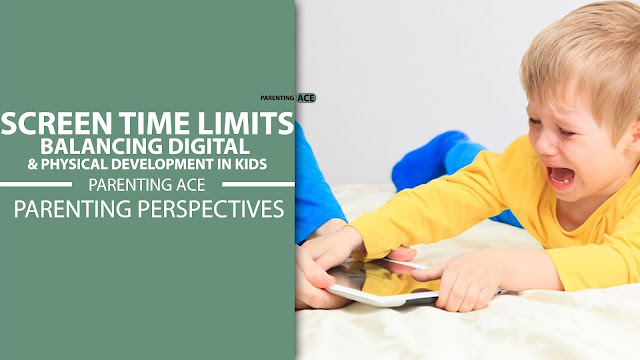Setting Limits on Screen Time: Balancing Digital Engagement with Physical Development in Children
In today's digital age, where screens abound, the challenge of balancing screen time with physical activity has become paramount for parents. Welcome to our latest blog post, where we delve into the vital topic of setting limits on screen time to nurture the physical development of children. From understanding the impact of excessive screen exposure on motor skills and overall health to implementing practical strategies for managing screen time, join us as we explore how to strike a healthy balance between digital engagement and physical activity in the modern parenting landscape.
 |
| Screen Time Limits: Balancing Digital & Physical Development in Kids |
In the digital age, children are increasingly exposed to screens, whether it's through smartphones, tablets, computers, or television. While technology offers numerous benefits, excessive screen time can have adverse effects on children's physical development. As parents, it's crucial to set limits on screen time to ensure a healthy balance between digital engagement and physical activities that support optimal growth and development.
Understanding the Impact of Screen Time on Physical Development
Excessive screen time can negatively impact children's physical health in several ways:
- Sedentary Lifestyle: Spending extended periods in front of screens often leads to a sedentary lifestyle, reducing opportunities for physical activity and exercise. This lack of movement can contribute to obesity, muscle weakness, and poor cardiovascular health.
- Delayed Motor Skills: Excessive screen time may interfere with the development of fine and gross motor skills. Instead of engaging in physical activities that promote coordination and dexterity, children may spend more time with passive screen-based activities, potentially delaying their motor skill development.
- Sleep Disruption: Screen time, particularly before bedtime, can disrupt sleep patterns and quality. Exposure to the blue light emitted by screens inhibits the production of melatonin, the hormone responsible for regulating sleep. Poor sleep quality can impair physical growth and cognitive function in children.
Setting Healthy Limits on Screen Time
To promote physical development and overall well-being, parents can implement the following strategies to set limits on screen time:
- Establish Clear Guidelines: Set clear rules regarding screen time limits, including duration and appropriate content. Communicate these guidelines with your child and emphasize the importance of balancing screen time with other activities.
- Lead by Example: Serve as a positive role model by demonstrating healthy screen habits yourself. Limit your own screen time and engage in physical activities with your child, such as outdoor play, sports, or family walks.
- Create Screen-Free Zones and Times: Designate specific areas in your home, such as bedrooms and mealtime areas, as screen-free zones. Additionally, establish designated screen-free times, such as during family meals or before bedtime, to encourage offline interactions and relaxation.
- Encourage Alternative Activities: Provide a variety of alternative activities that promote physical development and creativity, such as outdoor play, arts and crafts, sports, and board games. Encourage your child to explore different interests and hobbies beyond screens.
- Monitor Content and Quality: Be mindful of the content your child consumes during screen time. Choose age-appropriate, educational, and interactive media that encourages active engagement rather than passive consumption.
- Engage in Open Communication: Foster open communication with your child about screen time guidelines and the reasons behind them. Encourage discussions about the importance of balance, healthy habits, and the effects of excessive screen time on physical and mental well-being.
In conclusion, setting limits on screen time is essential for promoting physical development and overall health in children. By establishing clear guidelines, leading by example, creating screen-free zones and times, encouraging alternative activities, monitoring content, and engaging in open communication, parents can help their children strike a healthy balance between digital engagement and physical activities. Prioritizing quality time spent engaging in physical play, exploration, and social interactions fosters optimal growth and development, setting the foundation for a healthy and active lifestyle in the digital age.



Comments
Post a Comment